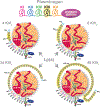The role of Lipoprotein(a) in cardiovascular disease: Current concepts and future perspectives
- PMID: 33039574
- PMCID: PMC8643135
- DOI: 10.1016/j.hjc.2020.09.016
The role of Lipoprotein(a) in cardiovascular disease: Current concepts and future perspectives
Abstract
High lipoprotein(a) [Lp(a)] levels are associated with the development of atherosclerotic cardiovascular disease (ASCVD) and with calcific aortic valve stenosis (CAVS) both observationally and causally from human genetic studies. The mechanisms are not well characterized but likely involve its role as a carrier of oxidized phospholipids (OxPLs), which are known to be increased in pro-inflammatory states, to induce pro-inflammatory changes in monocytes leading to plaque instability, and to impair vascular endothelial cell function, a driver of acute and recurrent ischemic events. In addition, Lp(a) itself has prothrombotic activity. Current lipid-lowering strategies do not sufficiently lower Lp(a) serum levels. Lp(a)-specific-lowering drugs, targeting apolipoprotein(a) synthesis, lower Lp(a) by up to 90% and are being evaluated in ongoing clinical outcome trials. This review summarizes the current knowledge on the associations of Lp(a) with ASCVD and CAVS, the current role of Lp(a) assessment in the clinical setting, and emerging Lp(a)-specific-lowering therapies.
Keywords: Cardiovascular disease; Lipoprotein(a).
Copyright © 2020 Hellenic Society of Cardiology. Published by Elsevier B.V. All rights reserved.
Figures

Comment in
-
Familial hypercholesterolaemia: New directions on the diagnosis and treatment of an old disease.Hellenic J Cardiol. 2020 Nov-Dec;61(6):404-406. doi: 10.1016/j.hjc.2020.06.014. Epub 2020 Jul 16. Hellenic J Cardiol. 2020. PMID: 32681886 No abstract available.
References
-
- Berg K A NEW SERUM TYPE SYSTEM IN MAN--THE LP SYSTEM. Acta Pathol Microbiol Scand 1963;59:369–382. - PubMed
-
- Gaubatz JW, Heideman C, Gotto AM, Morrisett JD, Dahlen GH. Human plasma lipoprotein [a]. Structural properties. J. Biol. Chem. 1983;258:4582–4589. - PubMed
-
- Utermann G, Weber W. Protein composition of Lp(a) lipoprotein from human plasma. FEBS Letters 1983;154:357–361. - PubMed
-
- McLean JW, Tomlinson JE, Kuang W-J, et al. cDNA sequence of human apolipoprotein(a) is homologous to plasminogen. Nature 1987;330:132–137. - PubMed
-
- Utermann G The mysteries of lipoprotein(a). Science 1989;246:904–910. - PubMed
Publication types
MeSH terms
Substances
Grants and funding
LinkOut - more resources
Full Text Sources
Miscellaneous

